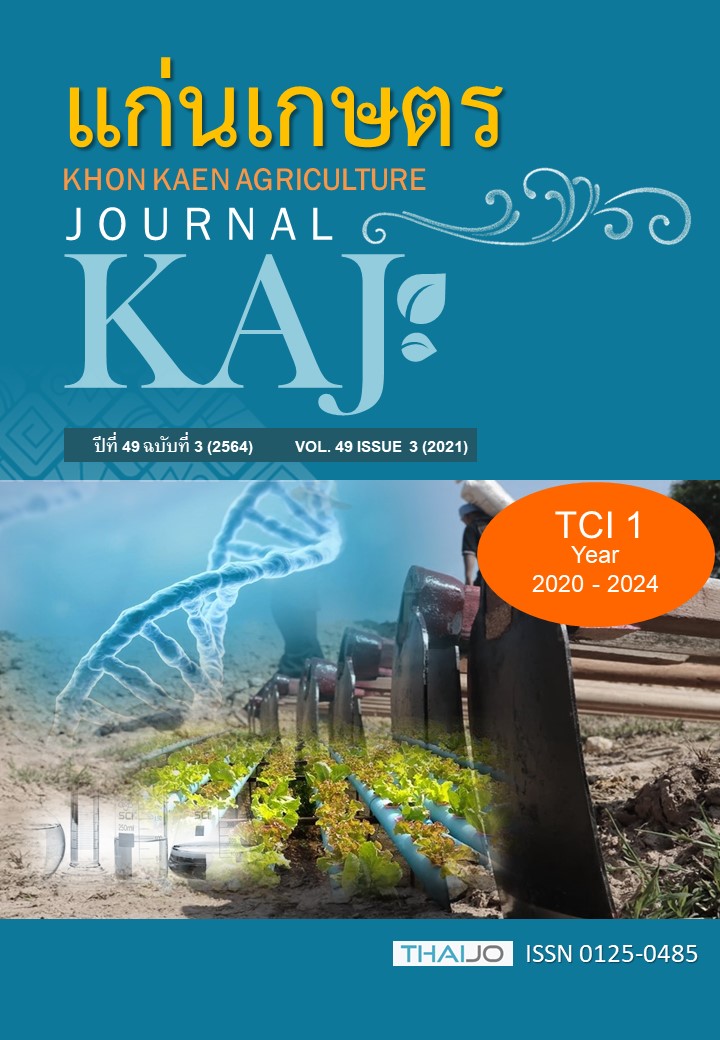การสำรวจเฝ้าระวังเฉพาะโรคกาบใบเน่าสีน้ำตาลของข้าวในแหล่งปลูกข้าวที่สูงจังหวัดเชียงรายและการจำแนกสาเหตุ
Main Article Content
บทคัดย่อ
ในปี พ.ศ. 2559 ได้ดำเนินการสำรวจเฝ้าระวังเฉพาะโรค เพื่อศึกษาเชื้อแบคทีเรียที่เป็นสาเหตุโรคกาบใบเน่าสีน้ำตาล และเมล็ดด่างของข้าวในพื้นที่ปลูกข้าวที่สูงของจังหวัดเชียงราย ใช้อาหาร King’s medium B (KMB) เพื่อคัดเลือกเชื้อกลุ่ม Pseudomonas ที่เรืองแสง แยกเชื้อแบคทีเรียดังกล่าวจำนวน 214 ไอโซเลท จากตัวอย่างข้าวที่แสดงอาการของโรค จากนั้นคัดเลือกตัวแทนเชื้อจากทุกแหล่งที่นำมาแยกเชื้อ จำนวน 77 ไอโซเลท ทดสอบปฏิกิริยาการตอบสนองอย่างเฉียบพลัน (hypersensitivity reaction, HR) บนยาสูบ พบ 8 ไอโซเลท ที่ให้ผลเป็นบวก และตรวจพบได้ด้วยเทคนิค PCR ด้วยไพรเมอร์ที่ออกแบบจำเพาะต่อยีน 16S rRNA ของ Pseudomonas fuscovaginae เมื่อนำไปวิเคราะห์ลำดับนิวคลีโอไทด์ของดีเอ็นเอที่ได้จาก PCR เปรียบเทียบกับฐานข้อมูล GenBank พบว่าเชื้อ 4 ไอโซเลท ได้แก่ 59PFCRMSO2-7 59PFCRMSO2-8 59PFCRMSO2-10 และ 59PFCRMU4-8 จัดอยู่ในกลุ่มเดียวกับ
P. fuscovaginae และทำให้เกิดโรคกาบใบเน่าสีน้ำตาลได้ การศึกษาคุณสมบัติต่าง ๆ ของเชื้อ พบว่าเมื่อเลี้ยงบนอาหาร KMB บ่มที่อุณหภูมิ 30°C เป็นเวลา 48 ชั่วโมง โคโลนีมีสีขาวครีมทึบแสง ลักษณะกลม (circular) โค้งนูนจากผิวหน้าอาหาร (convex) ขอบเรียบ (entire) โคโลนีมีขนาดเส้นผ่านศูนย์กลางเฉลี่ย 0.3-0.8 มม. เรืองแสงสีเขียวภายใต้แสงอุลตร้าไวโอเล็ต เป็นแบคทีเรียที่ต้องใช้ออกซิเจนในการเจริญ แกรมลบ รูปร่างเป็นท่อนตรง (rod shape) หัวท้ายมน ขนาดความกว้าง 0.5-0.8 ไมครอน และยาว 1.9-3.3 ไมครอน เมื่อเลี้ยงเชื้อบนอาหาร Nutrient agar เป็นเวลา 4-5 วัน ที่อุณหภูมิ 28°C โคโลนีจะมีเส้นผ่านศูนย์กลาง 4-6 มม. สร้างเอนไซม์ oxidase ย่อยเจลาติน ใช้อาร์จินีน และไม่รีดิวซ์ไนเตรทเป็นไนไตรท์ ไม่ใช้น้ำตาล sucrose arabinose trehalose 2-ketogluconate inositol sorbitol และ adonitol ซึ่งเหมือนกับเชื้อ P. fuscovaginae ยกเว้นสามารถเจริญได้ที่อุณหภูมิ 37°C เมื่อนำมาจัดจำแนกด้วยวิธี Multilocus sequencing analysis (MLSA) โดยวิเคราะห์ลำดับนิวคลีโอไทด์ของ housekeeping genes จำนวน 10 ยีน ที่นำมาเชื่อมต่อกัน ดังนี้ acsA aroE dnaE guaA gyrB mut ppsA pyrC recA และ rpoB พบว่าเชื้อแบคทีเรียทั้ง 4 ไอโซเลท จัดอยู่ในกลุ่มเดียวกันกับเชื้อ P. fuscovaginae สายพันธุ์ IRRI 6609 IRRI 7007 และ S-E1 (ฟิลิปปินส์) โดยมีค่าความเหมือนมากกว่า 99% และยังพบว่าลำดับนิวคลิโอไทด์ของจีโนมของเชื้อที่ศึกษามีความเหมือนกันของจีโนม กับของเชื้อ P. fuscovaginae สายพันธุ์ IRRI 6609 ในระดับที่มากกว่า 90% หลังการพบเชื้อและจำแนกเชื้อแล้วผู้วิจัยได้แจ้งให้กับกรมการข้าว และกรมวิชาการเกษตร เพื่อดำเนินการกำจัดเป็นที่เรียบร้อยแล้ว
Article Details

อนุญาตภายใต้เงื่อนไข Creative Commons Attribution-NonCommercial-NoDerivatives 4.0 International License.
เอกสารอ้างอิง
นิรนาม. 2554. การวางแผนวิธีการสำรวจแบบเฉพาะเจาะจง. แหล่งข้อมูล: http://aciar.gov.au/files/node/8516/
MN119c%20Part%203.pdf. ค้นเมื่อ 1 ตุลาคม 2559.
ราชกิจจานุเบกษา. 2550. กำหนดศัตรูพืชเป็นสิ่งต้องห้ามตามพระราชบัญญัติกักพืช พ.ศ. 2507 (ฉบับที่ 6) พ.ศ. 2550. แหล่งข้อมูล: http://www.ratchakitcha.soc.go.th/DATA/PDF/2550/E/066/4.PDF. ค้นเมื่อ 29 มกราคม 2563.
Bigirimana, V.D.P., G.K. Hua, O.I. Nyamangyoku, and M. Hofte. 2015. Rice sheath rot: an emerging ubiquitous destructive disease complex. Frontiers in Plant Science. 6: 1-16.
CABI. 2018. Pseudomonas fuscovaginae (sheath brown rot). Available: https://www.cabi.org/isc/datasheet/
44957. Accessed Oct. 16, 2019.
Cother, E. J., D.H. Noble, R.J. Van De Ven, V. Lanoiselet, G. Ash, N. Vuthy, P. Visarto, and B. Stodart. 2010. Bacterial pathogens of rice in the Kingdom of Cambodia and description of a new pathogen causing a serious sheath rot disease. Plant Pathology. 59: 944-953.
Cottyn, B., M. F. Van Outryve, M.T. Cerez, M.D. Cleene, J. Swings, and T.W. Mew. 1996. Bacterial diseases of rice. II. Characterization of pathogenic bacteria associated with sheath rot complex and grain discoloration of rice in the Philippines. Plant Disease. 80: 438-445.
Duveiller, E., K. Miyajima, F. Snacken, A. Autrique, and H. Maraite. 1988. Characterization of Pseudomonas fuscovaginae and differentiation from other fluorescent Pseudomonads occurring on rice in Burundi. Journal of Phytopathology. 122: 97-107.
Duveiller, E., J.L. Notteghem, P. Rott, F. Snacken, and H. Maraite. 1990. Bacterial sheath brown rot of rice caused by Pseudomonas fuscovaginae in Malagasy. International Journal of Pest Management. 36: 151-153.
Kumar S., G. Stecher, and K. Tamura. 2016. MEGA7: Molecular evolutionary genetics analysis version 7.0 for bigger datasets. Molecular Biology and Evolution. 33: 1870-1874.
Miyajima, K., A. Tanii, and T. Akita. 1983. Pseudomonas fuscovaginae sp. nov., nom. rev. International Journal of Systematic and Evolutionary Microbiology. 33: 656-657.
Zafri, M., K. Sijam, R. Ismail, M. Hashim, E. Hata, and D. Zulperi. 2015. Phenotypic characterization and molecular identification of Malaysian Pseudomonas fuscovaginae isolated from rice plants. Asian Journal of Plant Pathology. 9: 112-123.
Mulet, M., J. Lalucat, and E.G. Valdes. 2010. DNA sequence-based analysis of the Pseudomonas species. Environmental Microbiology. 12: 1513-1530.
Onasanya, A., A. Basso, E. Somado, E.R. Gasore, F.E. Nwilene, I. Ingelbrecht, J. Lamo, K. Wydra, M.M. Ekperigin, M. Langa, O. Oyelakin, Y. Sere, S. Winter, and R.O. Onasanya. 2010. Development of a combined molecular diagnostic and DNA fingerprinting technique for rice bacteria pathogens in Africa. Biotechnology. 9: 89-105.
Quibod, I.L., G. Grande, E.G. Oreiro, F.H. Borja, G.S. Dossa, R. Mauleon, C.V. Cruz, and R. Oliva. 2015. Rice-infecting Pseudomonas genomes are highly accessorized and harbor multiple putative virulence mechanisms to cause sheath brown rot. PLOS ONE. 10: 1-25.
Razak, A., N. Zainudin, S. Sidiqe, N. Ismail, N. Mohamad, and B. Salleh. 2009. Sheath brown rot disease of rice caused by Pseudomonas fuscovaginae in the Peninsular Malaysia. Journal of Plant Protection Research. 49: 244-249.
Rott, P. 1987. Brown rot (Pseudomonas fuscovaginae) of the leaf sheath of rice in Madagascar. Available: https://www.cabi.org/ISC/abstract/19881157248. Accessed Oct. 16, 2019.
Schaad, N. W., J. B. Jones, and W. Chun. 2001. Laboratory Guide for Identification of Plant Pathogenic Bacteria. 3rd Edition. APS Press, Minnesota.
Silvestro, D., and I. Michalak. 2010. Raxmlgui: A graphical front-end for raxml. Organisms Diversity and Evolution.
12: 1-3.
Tanii, A., K. Miyajima, and T. Akita. 1976. The sheath brown rot disease of rice plant and its causal bacterium, Pseudomonas fuscovaginae. Phytopathological Society of Japan. 42: 540-548.
Tayeb, L.A., E. Ageron, F. Grimont, and P.A.D. Grimont. 2005. Molecular phylogeny of the genus Pseudomonas based on rpoB sequences and application for the identification of isolates. Journal of Microbiology. 156: 763-773.
Yamamoto, S., H. Kasai, D.L. Arnold, R.W. Jackson, A. Vivian, and S. Harayama. 2000. Phylogeny of the genus Pseudomonas: intrageneric structure reconstructed from the nucleotide sequences of gyrB and rpoD genes. Journal of Microbiology. 146: 2385-2394.
Zeigler, R.S., and E. Alvarez. 1987. Bacterial sheath brown rot of rice caused by Pseudomonas fuscovaginae in Latin America. Plant Disease. 71: 592-597.


